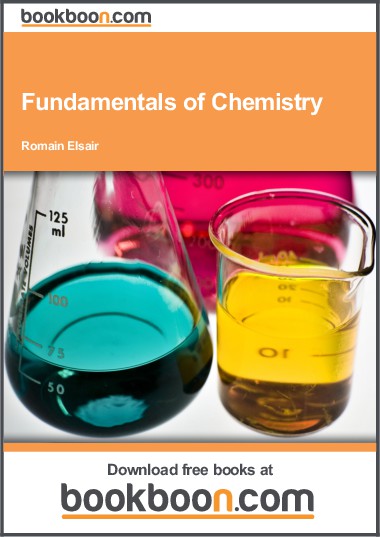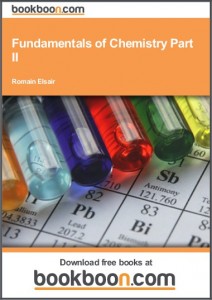Content
- Fundamentals of Chemistry
- Aim of this Book
- Scope of this Book
- Substances and Reactions
- Classifying Substances
- Solids, Liquids and Gases
- Changing state
- Element
- Metals & Non-metals
- Chemical symbols
- Compound
- Mixture
- Physical separation
- Physical and chemical change
- Elements, mixtures or compounds?

- Atomic theory
- Chemical formulae
- Ion
- Naming Compounds
- Chemical Equations Subatomic Structure Relative Atomic Mass
- Chemical equations
- Atomic Structure
- Fundamental subatomic particles
- Chemical Masses
- Mass spectrometer
- Th e Mole
- Introduction
- Why is the mole useful?
- Molecules
- Ionic compounds
- Useful relationships involving the mole
- Mass Percentage composition of elements in compounds
- Empirical formulae of compounds
- Th eoretical yield
- Percentage yield
- Limiting reagent
- Solutions and Concentrations
- Introduction
- Dissolving
- Concentration
- Changing volume
- Most useful unit of concentration – Molarity
- Equation to learn
- Ionic Solutions
- Diluting Solutions
- Th e pH scale
- Other units for concentration
- Electromagnetic Radiation and Spectroscopy
- Electromagnetic Spectrum
- Definition of Electromagnetic Radiation (EMR)
- Energy of Light
- Emission Spectra
- Absorption Spectra
- Uses of spectroscopy
- Quantum theory
- Interpreting electronic spectra
- Quantum-Mechanical Model
- Sublevels
- s orbitals
- p orbitals
- d orbitals
- Quantum Numbers
- Th e Pauli Exclusion Principle
- Electronic Confi guration
- Th e Aufb au Principle
- Summary
- Electron Confi guration Bonding Redox equations
- Valence Electrons and Bonding
- Valence electrons
- Bonding
- Lewis diagrams
- Single and multiple covalent bonds
- Redox reactions
- Summary
- Shapes of Molecules
- Exceptions to the octet rule
- Exceptions to the octet rule
- Limitations of Lewis structures
- Shapes of covalent molecules
- Molecules with lone pairs
- Distorted shapes
- Exercise – What shape is an ammonia molecule?
- Non-equivalent positions
- Molecules with lone pairs
- Limitations with Lewis structures
- Metallic bonding
- Ionic and Covalent
- Electronegativity
- Polar bonds
- Intermolecular forces
- Chemical Bonding and Solid Structures
- Introduction
- Giant metallic structures and their properties
- Giant Ionic structures and their properties
- Molecular structures and their properties
- Simple molecular structures and their properties
- Trends in the Periodic Table
- Historical trends
- Mendeleev’s table ()
- Modern Periodic Table
- Metals / non-metals
- Physical Properties
- Electronegativity
- Trends across a Period
- Trends down a Group
- Thermochemistry
- Introduction
- Forms of Energy
- Energy and Chemical Reactions
- Enthalpy, H
- Heat Energy and Chemical Reactions
- Enthalpy and Enthalpy Change
- Endothermic reactions
- Enthalpy and Enthalpy Change
- Th ermochemical equations
- Standard State Enthalpy Changes
- Standard State Enthalpies
- Specifi c heat capacity
- Standard State Enthalpies
- Summary
About the Author
Doctor Romain R. El Sair BSc, MSc, MPhil, PhD, AMRSC
Dr. Romain El Sair studied at the Universita degli Studi di Bologna, Italy (BSc), at the Université des Sciences et Techniques in Nantes, France (MSc) and Brighton, UK where he gained a Doctorate Degree in Organic Chemistry in the year 2010. Romain’s PhD thesis is entitled “Synthesis and Reaction of Novel Bridgehead Heterocycles” where he developed a quick and cheap approach to potentially synthesise anti-cancer molecules. Romain has spent three years from 2009 to 2011, teaching chemistry in both laboratories and classes.
He focussed his teaching on analytical and physical chemistry whilst laboratories were more organic chemistry orientated. Romain has taught students at various academic levels from A-Level to Masters Degree and has been involved in several research projects with BSc and MSc students. Romain is a Fellow Member of the Royal Society of Chemistry since 2006.
Since 2009, Romain started to work in the Renewables Energy sector where he specialised in the solar photovoltaic (PV) field. He currently works for a large engineering company based in Brighton, undertaking the technical assessment of multi-million solar PV plants for mainly Lenders, Invertors, Funds and Banks.
His major interest in the PV sector includes the estimation of the energy output generated by the plant and the assessment of the solar resource at any particular location on the planet. Romain has been involved with PV projects in several countries (France, Spain, UK, Czech Republic, Italy, Bulgaria, Greece, South Africa and Thailand).


